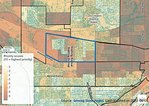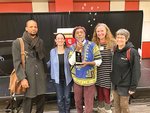


Hello Monitor readers,
January and February were very tough months of natural and human acts of physical, mental, and emotional harm and tragedy that continues to challenge our values, beliefs, and worldviews. It feels too draining and emotionally charged even to list the record numbers of senseless and cruel single and mass killings, the unbelievable tens of thousands of earthquake victims, and of the ongoing death tally of the year-long Ukraine and Russian war along with all the other non-stop wars and battles globally. Not to mention, our unresolved border (north and south) srossings challenges, polarizing politics (politics before country lawmakers), and everyday people feeling abundantly scared and fearful of each other and of those who are to serve us – it is making the start of 2023 a year not for the faint of heart.
A Children’s Garden educator at the Peace Sanctuary Garden sent an email message to the garden’s planners and helpers expressing “In the midst of hardship, there is hope.” At the time I didn’t take her message in; however, after receiving and hearing news of St. Paul’s deadly last weekend in February, I was grateful for her message. I’m still holding on to her message because no matter what my eyes see, I still know that good men and women are still serving us. We often call them First Responders. I still know that good young women and men and kids are loving human beings, and I really know that we do have good lawmakers who honor country over political competition and outdated toxic racist and sexist thinking. And, I really, really know that good folks way outnumber the not good stinkers and bad human apples!
Yet, I am aware that humans need a sense of immediate safety, or at the least, answers that lead to safety of their world-views. I asked two of my White allies to speak to a comment that was made to the Monitor via email and comments that I also have been receiving from my White friends regarding the heartbreaking and fatal weekend tragedies. I informed my allies that I was still reflecting and grieving and trying to understand it myself. I also shared that I thought it would be more appropriate for a White person to reply to another White person’s suggested inquiry – if poverty or hopelessness was at the core or root of the shootings. I am sharing one response this month and the other next month. I also want to invite readers of all colors (Black, Brown, White) to feel comfortable sending an answer or comment to the editor.
From Terry Burke: As a White woman, I’d like to see us stop incarcerating Blacks at a rate five times higher than whites. (https://www.cnn.com/2021/10/13/politics/black-latinx-incarcerated-more/index.htm) How can Black youth have hope for the future when they know how our country imprisons Black men at such a high rate? Major white collar crime rarely results in prison while nonviolent crimes by Blacks can result in long prison sentences. We need to be involved. Learn about the Twin Cities Incarcerated Workers Organizing Committee and how they are working to transform the prison system in Minnesota.
Thank you, Terry!
Community Forests in Midway Neighborhoods Contribute to Environmental Justice By Molly Codding:
Our urban trees provide many community benefits. Economically, trees improve property values, lower energy costs, and provide growing career opportunities. A host of public and private tree care industry organizations afford technically proficient, competitive employment opportunities with good wages and pathways to entrepreneurship. Environmentally, tree roots intercept stormwater runoff and improve the quality of water entering our lakes and rivers. The impact of trees on our watersheds is even more important in urban neighborhoods with more impervious surfaces like roads and parking lots. Trees also remove air pollution and improve air quality. Urban canopy provides communities with practical strategies for climate resilience. Trees sequester carbon and will help to buffer some of the worst impacts of climate change for Minnesotans, reducing environmental threats to the health of urban communities now and in the future.
Urban forests also improve our physical, mental, and emotional well-being by lowering stress, facilitating nature connections for residents of all ages, and providing neighbors with opportunities to be more socially connected outside. Tree canopy delivers relief from urban heat island effects via its vibrant shade, which can cool air temperatures up to 15 degrees Fahrenheit and reduces the risk of heat-related illness for vulnerable community members. Neighborhoods with higher canopy coverage have better air quality and are associated with lower rates of asthma and asthma-related hospitalizations.
Unfortunately, not all canopies are distributed evenly. Inequities in forest distribution leave urban neighborhoods like Midway with less trees (26% canopy coverage) than the St. Paul average (34.5%), and much less than Metropolitan Council goals of 45% coverage to deliver all these tree benefits to community members (Met Council, 2022). A new regional data tool, Growing Shade, helps communities across the Twin Cities metro prioritize areas for canopy projects that center the environmental justice (see image on page 8).
Environmental justice areas of concern are often associated with increased proportions of populations of Black, Indigenous, and Persons of Color and with decreased average median household income. This pattern is present in the Twin Cities metro, in other communities in Minnesota, and in cities across the United States. Why is this? Racially discriminatory practices like redlining, disproportionate public disinvestment in infrastructure (including trees and parks), as well as land-use decisions and processes which disenfranchise residents mean that less environmental benefits are afforded to Communities of Color and communities with lower socioeconomic status.
This is where tree huggers, community lovers, and social justice advocates unite! Environmental injustices like inequitable canopy cover are a systemic problem which require environmentalists, community organizers, non-profit organizations, academic institutions, and multiple levels of government to contribute to its solutions. Fighting for environmental justice requires old silos to be torn down and new collaborations which serve common aims to be fostered. Urban canopy equity work must center the priorities, values, and needs of communities most impacted by injustice. Through fundamental principles of mutuality, reconciliation, and relationship-building, we can ensure that urban forests in Midway and across St. Paul deliver environmentally just benefits for future generations.
SPRING IS BLOOMING
Staying optimistic is hard and challenging, and it takes much faith and working and struggling together. Every day I’m reminded by an anonymous writer that “Hope is not pretending that troubles don’t exist… It is the trust that they will not last forever, that hurts will be healed, and difficulties overcome… It is the faith that a Source of strength and renewal lies within to lead us through the dark to the sunshine…”
It’s okay to feel our sorrow, our pain, our fears, and our frustrations and we can still keep hope, optimism, joy, and love alive within us. Spring is blooming!
May Peace Be In the Rondo, Frogtown, Hamline/Midway, Como, and Surrounding Communities...
May Peace Be In Our Homes & Communities…
May Peace Prevail On Earth (MPPOE)!
Comments
No comments on this item Please log in to comment by clicking here